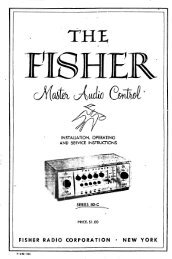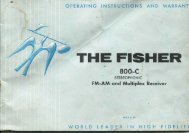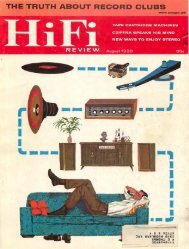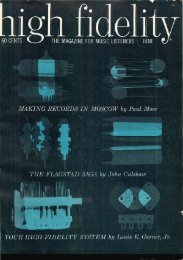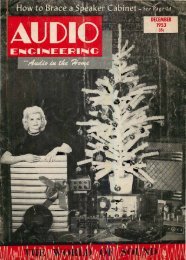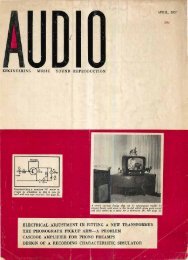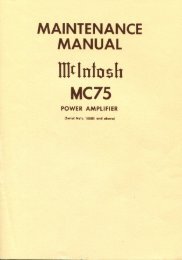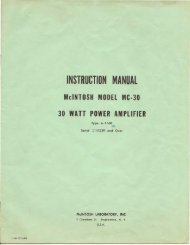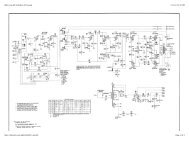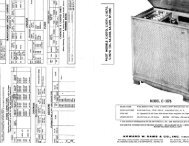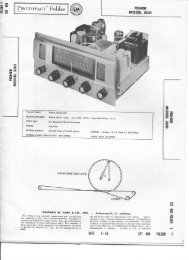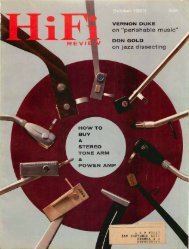~flr'6,r"®
Hifi Stereo Review â July 1958 - Vintage Vacuum Audio
Hifi Stereo Review â July 1958 - Vintage Vacuum Audio
- No tags were found...
You also want an ePaper? Increase the reach of your titles
YUMPU automatically turns print PDFs into web optimized ePapers that Google loves.
I Direct drive by reduction gear, a<br />
principLe favored by Thorens.<br />
Inner rim drive ,via pulley and idler<br />
is used on many makes.<br />
Elastic belt drive helps filter out motor<br />
vibration.<br />
34<br />
used to reaching for the stars when<br />
he designed the drive mechanism<br />
for the giant telescope at Mount<br />
Palomar. Among the unique featnres<br />
he designed into the Scott<br />
Model 7l0A is a helical gear drive<br />
running in an oil bath, and a rigid<br />
yoke between the turntable and a<br />
floating platform where the tone<br />
arm is to be mounted. Linked by<br />
this yoke, the turntable and the arm<br />
respond in unison to any outward<br />
shock or bump, so that shaky floors,<br />
passing trucks, heavy-footed dancers<br />
and romping children have<br />
hardly any effect on the playing,<br />
An entirely opposite design philosophy<br />
is evinced by the Swiss nrm<br />
of Thorens in their solution of the<br />
vibration and "rumble" problem.<br />
Their design has no elastic elements<br />
at all. In keeping with the<br />
Swiss tradition of precision craftsmanship,<br />
Thorens turntables employ<br />
a direct gear drive, and trust<br />
in accmate machining and balancing<br />
of all rotating parts to assure<br />
smooth operation. However, in their<br />
latest model, the TD-124 transcription<br />
turntable, Thorens designers<br />
employ a rubber belt and rubberrimmed<br />
idlers to achieve mechanical<br />
isolation of the turntable from<br />
the motor.<br />
So far we have been mainly concerned<br />
with the manner of transmitting<br />
rotational power from the<br />
motor to the hlrntable. About the<br />
turntable platter itself, the obvious<br />
questions are: How does it turn?<br />
What holds it up?<br />
There is something of a h'ick to<br />
this because friction in the turntable<br />
bearings can cause noise from<br />
the speaker if the frictional vibration<br />
is picked up along with the<br />
music. To keep friction at a minimum,<br />
the turntable platter in many<br />
designs rotates on a single precision<br />
ball bearing. The turntable thus<br />
spins almost without friction, supported<br />
at only a single point, somewhat<br />
like a dancer pirouetting on<br />
the tip of her toe.<br />
For this type of motion, the dancer<br />
must balance her body. Likewise,<br />
the turntable platter must be perfectly<br />
balanced so that it will not<br />
run lopsided. Good huntables are<br />
therefore machined on precision<br />
lathes and dynamically tested. These<br />
rests resemble the balancing of car<br />
wheels. The hlrntables are spun at<br />
speeds so high that even the slightest<br />
unevenness in their weight distribution<br />
shows up immediately.<br />
After snuffing out every trace of<br />
vibration, we still face the stern requirement<br />
of constant speed. The<br />
hmling rate must be rock-steady.<br />
That's why a precision motor is a<br />
must. It is, in effect, the "prime<br />
mover" of the phonograph.<br />
An inadequate motor won't pull<br />
evenly at all points of the circle.<br />
The result is a chugging motion<br />
which shows up in the reproduced<br />
sound as a fast waver of pitch,<br />
known as "flutter." It gets the music<br />
literally "all shook up," afBicting it<br />
with a kind of tonal shivers. The<br />
clear, solid sound of a real performance<br />
turns into a kind of weak,<br />
tremulous pudding.<br />
Sometimes the pitch wavers at a<br />
lower rate. The music then wallows<br />
up and down like a schooner in<br />
high seas. This is known as "wow"<br />
but the expression connotes no delight<br />
to hi-ners.<br />
Such "flutter" and "wow" are the<br />
bane of cheap phonographs and an<br />
unfailing irritant to listeners' nerves.<br />
To avoid these periodic ups-anddowns<br />
in pitch, the hu'ntable speed<br />
must be constant within a fraction<br />
of one percent. Such accuracy starts<br />
with the design of the motor itself.<br />
The two-pole motors of cheap<br />
turntables are simply unnt for hi-no<br />
Four-pole motors, however, are capable<br />
of excellent results since their<br />
pull (called "torque by technicians)<br />
is quite well smoothed out.<br />
But for ultinlate quality, some deluxe<br />
turntables employ a hysteresis<br />
motor whose pulling force remains<br />
fully constant throughout each turn.<br />
Turntable Weight<br />
The turntable platter can help<br />
the motor achieve constant rotation<br />
by its sheer weight. A heavy, balanced<br />
turntable acts as a flywheel.<br />
Its momentum smoothes ripples in<br />
the rotary pull. Many high-quality<br />
turntables therefore stress weight<br />
as an important quality factor.<br />
Rek-O-Kut, Presto, Garrard, Connoisseur,<br />
Intersearch, Lafayette and<br />
Gray are the high priests of the<br />
heavyweights-all proved reliable<br />
performers.<br />
Taking a different approach<br />
Mr. Minter of Components Corporation<br />
and Mr. Weathers of Weathers<br />
Industries, having licked the<br />
vibration problem through their<br />
HIFI & MUSIC REVIEW<br />
I




